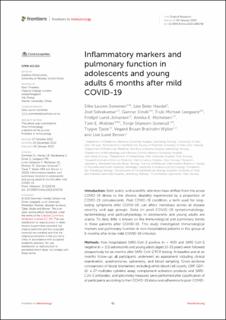| dc.contributor.author | Sommen, Silke Lauren | |
| dc.contributor.author | Havdal, Lise Beier | |
| dc.contributor.author | Selvakumar, Joel Pradeepkumar | |
| dc.contributor.author | Einvik, Gunnar | |
| dc.contributor.author | Leegaard, Truls Michael | |
| dc.contributor.author | Lund-Johansen, Fridtjof | |
| dc.contributor.author | Michelsen, Annika Elisabet | |
| dc.contributor.author | Mollnes, Tom Eirik | |
| dc.contributor.author | Stiansen-Sonerud, Tonje | |
| dc.contributor.author | Tjade, Trygve Olav | |
| dc.contributor.author | Wyller, Vegard Bruun Bratholm | |
| dc.contributor.author | Lund-Berven, Lise | |
| dc.date.accessioned | 2023-02-22T09:31:39Z | |
| dc.date.available | 2023-02-22T09:31:39Z | |
| dc.date.created | 2023-02-17T10:49:25Z | |
| dc.date.issued | 2022 | |
| dc.identifier.citation | Frontiers in Immunology. 2022, 13:1081718 1-12. | en_US |
| dc.identifier.issn | 1664-3224 | |
| dc.identifier.uri | https://hdl.handle.net/11250/3053067 | |
| dc.description.abstract | Introduction: Both public and scientific attention have shifted from the acute COVID-19 illness to the chronic disability experienced by a proportion of COVID-19 convalescents. Post COVID-19 condition, a term used for long-lasting symptoms after COVID-19, can affect individuals across all disease severity and age groups. Data on post-COVID-19 symptomatology, epidemiology and pathophysiology in adolescents and young adults are scarce. To date, little is known on the immunological and pulmonary trends in these patients after COVID-19. This study investigated immunological markers and pulmonary function in non-hospitalized patients in this group at 6 months after initial mild COVID-19 infection.
Methods: Non-hospitalized SARS-CoV-2 positive (n = 405) and SARS-CoV-2 negative (n = 111) adolescents and young adults (aged 12-25 years) were followed prospectively for six months after SARS-CoV-2 PCR testing. At baseline and at six months follow-up, all participants underwent an assessment including clinical examination, questionnaires, spirometry, and blood sampling. Cross-sectional comparisons of blood biomarkers; including white blood cell counts, CRP, GDF-15, a 27-multiplex cytokine assay, complement activation products and SARS-CoV-2 antibodies; and spirometry measures were performed after classification of all participants according to their COVID-19 status and adherence to post-COVID-19 case criteria. Associations between biomarkers and COVID-19 symptoms were explored.
Results: No difference in pulmonary function was detected between the groups. COVID-19 convalescents had higher levels of chemokines eotaxin, MCP-1 and IP-10 than non-infected controls. The increase was modest and not associated with long-lasting COVID-19 symptoms.
Discussion: Elevated inflammatory mediators were found in adolescents and young adults six months after mild COVID-19, but there was no association with post-COVID-19 condition. | en_US |
| dc.language.iso | eng | en_US |
| dc.publisher | Frontiers Media | en_US |
| dc.rights | Navngivelse 4.0 Internasjonal | * |
| dc.rights.uri | http://creativecommons.org/licenses/by/4.0/deed.no | * |
| dc.title | Inflammatory markers and pulmonary function in adolescents and young adults 6 months after mild COVID-19 | en_US |
| dc.title.alternative | Inflammatory markers and pulmonary function in adolescents and young adults 6 months after mild COVID-19 | en_US |
| dc.type | Peer reviewed | en_US |
| dc.type | Journal article | en_US |
| dc.description.version | publishedVersion | en_US |
| dc.source.pagenumber | 1-12 | en_US |
| dc.source.volume | 13:1081718 | en_US |
| dc.source.journal | Frontiers in Immunology | en_US |
| dc.identifier.doi | 10.3389/fimmu.2022.1081718 | |
| dc.identifier.cristin | 2126909 | |
| dc.relation.project | Norges forskningsråd: 223255 | en_US |
| cristin.ispublished | true | |
| cristin.fulltext | original | |
| cristin.qualitycode | 1 | |

